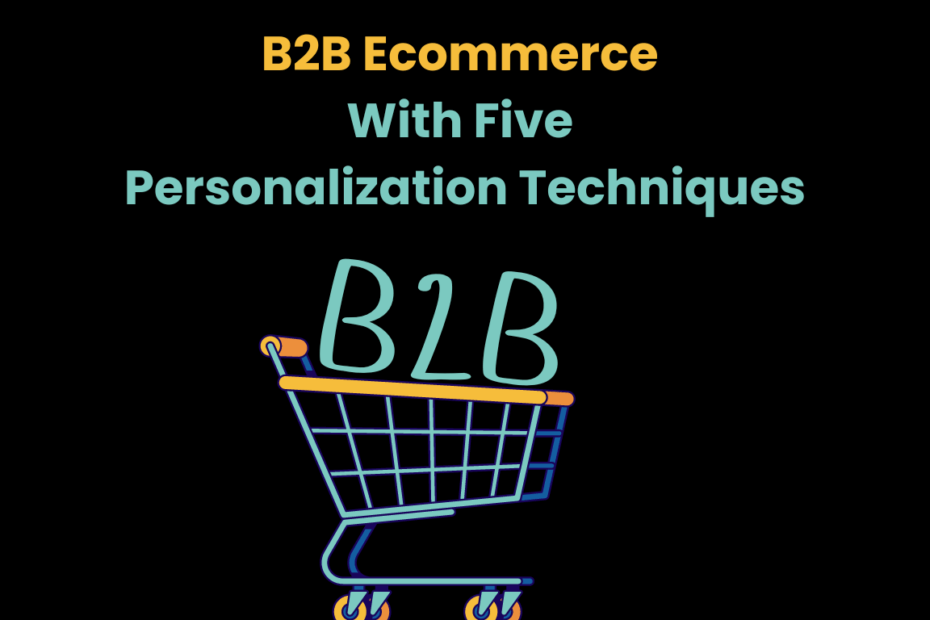Transforming B2B Ecommerce With Five Personalization Techniques
Imagine shopping for something, and every product on every shelf is tailor-made just for you. They know your preferences and past purchases and even anticipate what you’ll need before you need it.
The level of personalized service you get is very high. It makes you feel educated and valued while shopping, making the process more efficient and completely rewarding. Now, imagine taking this level of personalization online into B2B e-commerce.
These days, in today’s fast-paced business environment, digitals are becoming tomorrow’s norm, and personalization is no longer a luxury; it’s a need. The rise of digital B2B transactions means more than ever, and E-commerce app development services play a crucial role in enabling businesses to create seamless, personalized shopping experiences.
Businesses must create authentic, personalized customer experiences. The following examines how five fundamental personalization techniques can transform B2B ecommerce to provide a better customer experience and increase sales growth.
Five Key B2B Ecommerce Personalization Techniques

-
Customized Product Catalogs
One of the pillars of personalization in B2B e-commerce is tailoring product catalogs according to the customer’s sole profile and record of previous purchases, which provides additional user experience.
Unlike B2C, emotional appeal may be a dominant factor in purchasing decisions in B2B environments, but B2B buyers are more interested in functionality and efficiency. They know the precise product they need and love a streamlined process where they can find a product quickly.
One way to reduce customers’ time searching for relevant items is to provide customized product catalogs for B2B ecommerce personalization. Businesses can generate a curated product selection that aligns with customers’ needs.
They analyze past purchases and browsing behaviors. It enhances customer shopping experiences and increases conversion rates by showing relevant products based on their criteria.
-
Role-Based Personalization
Personalization based on roles diminishes the requirements of understanding various roles within a client organization and optimizing content and product recommendations based on those roles. It ensures that users get information and product suggestions according to their needs.
Take a procurement officer and an engineer, for instance; they might receive information on buying in bulk and discounts for both or detailed technical specifications and product manuals for the latter.
For example, a software company can use role-based personalization to give procurement managers pricing, contract details, technical documentation, and support resources to engineers. An organization can apply this approach by tailoring it to the specific needs of each stakeholder.
-
Industry-Specific Content
Firmographic data can help businesses provide their customers with the right industry-specific products. This may mean formulating customized marketing strategies for specific industries based on varying audiences’ requirements and problems.
For instance, a company that sells safety equipment may craft its marketing messages aligned with the marketing needs of the construction and healthcare industries. Similarly, businesses offering power solutions, such as industrial generators by Bay City Electric Works , can tailor their messaging to address the unique energy demands of industries like manufacturing or data centers. A company serving multiple industries can use industry-specific content for relevant product recommendations and case studies.
For example, while they may discuss various types of safety solutions for the automotive or pharmaceutical industries, they ensure that each customer gets pertinent information tailored to their field.
-
Personalized Pricing Strategies
Personalized pricing strategies are contract-specific pricing to simplify purchasing. Pricing is all about transparency, which builds customer trust and makes them more likely to repeat business with you.
For instance, a company might discount its purchase price based on the customer’s buying history and contract terms. B2B sales on Amazon Business use purchase focus-based pricing.
It discounts customers based on their purchasing volume or Amazon Business contracts. This method minimizes transaction complexities and builds the basis for durable relationships by generating value and transparency.
-
Geolocation-Based Personalization
Geolocation-based personalization refers to personalization based on location data collected from customers. It can range from showing local product availability to promoting regional events and running location-specific promotions.
While geolocation tactics help businesses become more relevant to customers, they also create meaningful connections. For example, a business could utilize geolocation data to show customers where products are available in nearby stores.
It could offer promotions for an upcoming local event or highlight specific products focused on a region. Localizing this experience enables the development of a more relevant and exciting shopping experience.
Implementing Personalization Techniques
-
Collect and Analyze Customer Data
A comprehensive collection of customer data reflecting their behavior, preferences, and needs is a valuable resource for analysis. This data may include previous purchases, browsing habits, age, gender, and education.
-
Segment Customers
Create personalization strategies using customer data segments to initiate them. Depending on the sector, the size of the company, and the users’ job titles, you can make several subdivisions.
-
Implement Personalization Tools
Use personalization instruments and technologies, such as recommendation engines and dynamic content, to create personalized experiences. These tools deliver tailored product recommendations, customized pricing, and relevant content. To help guide this process effectively, Store Owner Tips can provide practical advice on implementing these strategies in your business.
-
Monitor and Adjust
The personalized strategies should be monitored consistently and corrected if necessary. This means using customer feedback to track KPIs and adjust personalization strategies.
Measuring the Impact of Personalization
To evaluate personalization strategies, you can track several KPIs like:
- Customer engagement (interaction with personalized content),
- Conversion rates (personalized interactions leading to sales),
- Customer retention (repeat purchases), and
- Revenue growth (overall sales impact).
These metrics help gauge the effectiveness of personalization efforts.
Read More : Top 10 Wholesale B2B Marketplaces in the World in 2025
Conclusion
Personalization is a game changer for B2B e-commerce. Modern industrial enterprises stand to gain significantly from it. Through it, companies can improve the customer experience, grow deeper client relationships, and drive sales growth. As the digital landscape endlessly evolves, personalization will still be the main factor determining which companies win in B2B e-commerce.

